
I’m not gonna lie. The first time someone suggested I “just meditate” to deal with my stress, I almost laughed in their face. My mind was a chaotic mess, a browser with 50 tabs open, all blaring different alarms, and they thought I could just… what? Find an off switch?
Yeah, right. It felt completely impossible.
I had this image in my head of sitting in a perfect lotus position for an hour, chanting “Om,” and trying to achieve a totally blank mind. Spoiler alert: that’s a myth. For most of us, at least.
The real goal of meditation for stress relief isn’t about emptying your mind. It’s about giving your frantic brain one simple thing to focus on so the other 49 tabs can finally quiet down. It’s about learning to watch the mental chaos without getting sucked into the tornado. These ridiculously simple meditation techniques are the lifeline you need when you’re drowning in to-do lists and what-ifs. This isn’t about becoming a monk; it’s about managing meditation for anxiety so you can be a slightly less frazzled version of yourself.
Okay, But Why Are We Trying These Simple Meditation Techniques?
I totally get the skepticism. It can feel a little bit “woo-woo” at first. But here’s the deal. When you’re stressed or anxious, your body flips into fight-or-flight mode. It’s a primal survival thing. Your heart pounds, your breathing gets shallow, and your brain is basically a smoke alarm screaming DANGER! Even if the “danger” is just a passive-aggressive email from your boss, that’s where AI in healthcare is helping us understand and manage these reactions better.
Meditation is like a pattern interrupt for that system. It manually flips the switch from “panic” to “it’s cool, we’re safe.” It slows your heart rate, deepens your breath, and gives your brain a much-needed break from its own drama. Honestly, it’s one of the most effective stress management techniques because you don’t need anything to do it. You can do it anywhere, anytime.

10 No-Nonsense Approaches to Meditation for Stress Relief
Forget everything you think you know about meditation. You don’t need a fancy cushion. You don’t need an hour of silence. You just need a few minutes and a willingness to try something that feels a little weird at first.
1. The ‘Just Breathe’ Method: Your Foundation for Deep Breathing Techniques
If you only try one thing on this list, make it this one. Seriously. It’s the cornerstone of everything, and it’s called “box breathing.” You can do it during a boring Zoom meeting, and nobody will have a clue.
Step 1: Breathe in slowly through your nose for a count of 4.
Step 2: Just hold that breath for a count of 4.
Step 3: Breathe out slowly through your mouth for a count of 4.
Step 4: Hold again at the bottom of the breath for a count of 4.
Repeat.
That’s it. You’ve given your brain one job: count to four. This is one of the most fundamental deep breathing techniques, and it’s a game-changer.
2. The Body Scan: A Quick Relaxation Meditation for Beginners
Ever notice how anxiety shows up physically? A tight chest, a clenched jaw, and shoulders up by your ears. A body scan helps you tune into that without judging it.
Just find a comfortable spot (sitting or lying down, whatever works). Close your eyes and bring your attention all the way down to your toes. Just… notice them. Are they cold? Tense? Wiggling? Then, slowly, move that focus up your body, feet, calves, knees, all the way to the top of your head. You’re not trying to change anything. Just noticing. It’s a surprisingly powerful form of relaxation meditation.
3. Walking Meditation: Stress Management Techniques in Motion
Do you hate sitting still? Perfect. This one’s for you.
You don’t have to walk super slowly or look weird. Just walk at your normal pace and pay attention. Focus on the feeling of your feet on the pavement. Heel, ball, toe. Notice the air on your skin. The sounds of the city or the birds. Your mind will wander to your grocery list. That’s a guarantee. When it does, just gently guide your focus back to the feeling of walking. It’s basically mindfulness for mental health while getting your steps in.
4. The 5-4-3-2-1 Grounding Technique
This is my emergency brake for a panic attack. When your thoughts are spiraling out of control, this yanks you right back to the present moment. It’s so, so simple.
Wherever you are, name:
5 things you can see (a lamp, a crack in the wall, your own hand).
4 things you can physically feel (the texture of your jeans, the chair under you).
3 things you can hear (the hum of the fridge, a car outside).
2 things you can smell (stale coffee, your hand sani thing you can taste (your own tongue, the remnants of your gum).
And just like that, you’re back in the room.
5. Mindful Observation: The ‘Stare at a Pen’ Method
Pick a random object near you: a coffee mug, a plant, a dusty knick-knack. For sixty seconds, just look at it. I mean, really look at it. Notice its texture, the way the light reflects off it, the tiny imperfections.
Your brain will immediately go, “Yep, that’s a mug,” and try to move on. Your job is to pull it back and just keep observing gently. It’s a fantastic little mental reset you can do a dozen times a day.”
6. Mantra Meditation: Give Your Brain a Better Thing to Say
Sometimes the best way to quiet a noisy brain is to give it a calmer noise to play on a loop. A mantra is just a word or phrase you repeat to yourself.
It doesn’t have to be some ancient Sanskrit phrase. It can be:
- I am okay.
- Breathing in, breathing out.
- Or even just the word calm.
As you breathe, just repeat your mantra silently. When another thought barges in (and it will), just acknowledge it and go back to your word. It’s an anchor in a mental storm.
7. Visualization: Your Mental ‘Happy Place’
I know, I know. It sounds like something from a cheesy self-help book. But it actually works. Close your eyes and build a picture in your mind of a place where you feel 100% safe and relaxed. A quiet beach, a cozy cabin, a sunny forest.
Use all your senses. What do you see? What sounds are there? What does it smell like? Let yourself just be there for a few minutes. It’s a free mini-vacation for your nervous system and a great tool for understanding how to use meditation for emotional balance.
8. Mindful Listening: Just Hear the World
This one is amazing if you’re in a loud place. Instead of getting annoyed by the sounds, just listen. Sit down, close your eyes, and just let your ears do their thing.
Don’t label the sounds (“That’s a truck,” “That’s a dog”). Just notice the raw data, the pitch, the rhythm, and the volume. Let the soundscape wash over you without judging it. You’re training your brain to be an observer instead of a cranky commentator.
9. Gratitude Meditation: Flip the Script on Your Brain
Stress and anxiety are experts at pointing out what’s wrong, what’s scary, and what’s missing. Gratitude completely flips that script.
Take a single minute to think of three specific, small things you’re grateful for right now. The warmth of your socks. The taste of your coffee. A funny meme a friend sent you. Really try to feel the appreciation for each one. This is one of the easiest ways to reduce stress naturally.
10. Loving-Kindness Meditation: Sending Out Good Vibes (Even if it Feels Weird)
Okay, stick with me here. This one can feel a little strange at first, but it’s incredibly powerful for cultivating compassion.
Start by silently repeating these phrases for yourself:
- May I be happy.
- May I be safe.
- May I be healthy.
- May I live with ease.
Then, picture someone you love and repeat the phrases for them. Then, for someone neutral, like the mail carrier. And finally, if you’re up for it for someone you find difficult. You’re not letting them off the hook for anything; you’re freeing yourself from carrying around all that heavy, negative energy.
So, How Do I Actually Make This a Thing?
Awesome, you’ve got a list of ideas, but now what? The key is to start really small. Don’t make big promises like meditating for 20 minutes every day. Just commit to one minute.
The goal isn’t to have long meditation sessions; it’s to build a steady habit. Even one minute every day is far better than 30 minutes once a month. A Healthcare Software Development Company can even design apps that help you stay consistent with gentle reminders or short guided practices.
Choose one simple technique that feels easiest to try. Maybe do a quick round of box breathing while your computer starts up, or a short body scan before you sleep. These tiny moments of calm can make a huge difference; that’s the real secret behind meditation for beginners.
Final Thoughts
Let’s be real, these simple meditation techniques aren’t some magic fix. You’ll still have tough days, and your mind will still act up sometimes. That’s just how life is.
Meditation isn’t about being perfectly calm or never feeling stressed again. It’s about finding a bit of peace in the middle of the chaos, knowing you have the tools to ride out those waves of stress and anxiety. An app development company can even help by building apps that make it easier to practice mindfulness every day.
FAQs:
Q.How long do I actually have to meditate?
Honestly? One to three minutes is a perfect place to start. Consistency is so much more important than duration. Once you get the hang of it, you can go longer, but even five solid minutes a day can make a massive difference.
Q.What if my mind just won’t shut up? I’m thinking about everything!
Join the club! That’s literally everyone’s experience. The goal isn’t an empty mind, which is pretty much impossible. The goal is to notice when your mind has wandered off, and then gently, without beating yourself up, guide it back to your breath (or mantra, or whatever). It’s like training a puppy. You just patiently bring it back, again and again.
Q.Do I need a special cushion or an app or something?
Nope. All you need is yourself and a place to sit or lie down. A chair, the floor, your bed, whatever’s comfy. Apps can be great for guided stuff, but you absolutely don’t need one to get started. The best step-by-step meditation for beginners is often the one that requires zero equipment.
Q.Is there a “best” time of day to meditate?
The best time is the time you’ll actually do it. That’s it. Some people love it first thing in the morning to set a calm tone for the day. Others use it for a midday reset when work gets crazy. Many use it right before bed to wind down. Just experiment and see what clicks with your schedule.
Q.How fast will I feel better using these stress management techniques?
It depends. Some things, like the 5-4-3-2-1 grounding trick or a few rounds of box breathing, can give you immediate relief in a high-stress moment. The bigger, more lasting benefits, like feeling less reactive in general, come from consistent practice over time. Be patient with yourself. You’re building a new skill, not flipping a switch.








